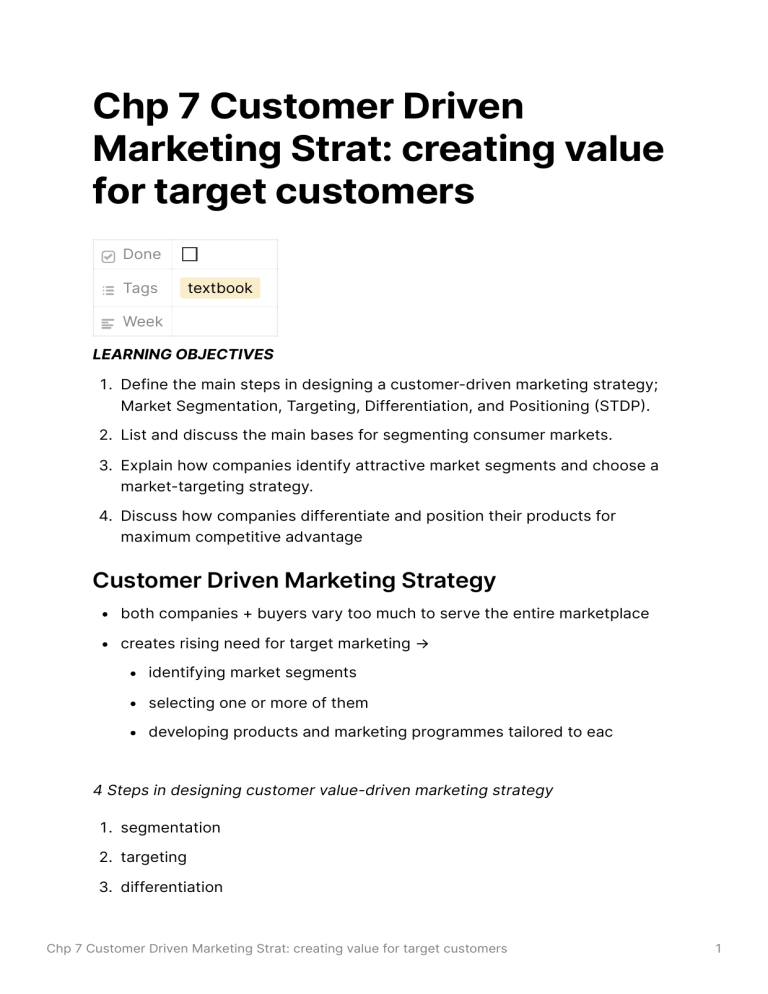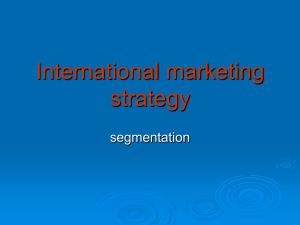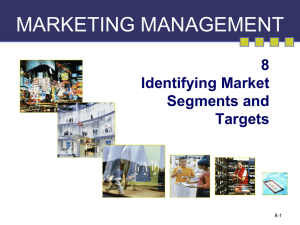
Chp 7 Customer Driven Marketing Strat: creating value for target customers Done Tags textbook Week LEARNING OBJECTIVES Define the main steps in designing a customer-driven marketing strategy; Market Segmentation, Targeting, Differentiation, and Positioning STDP. List and discuss the main bases for segmenting consumer markets. Explain how companies identify attractive market segments and choose a market-targeting strategy. Discuss how companies differentiate and position their products for maximum competitive advantage Customer Driven Marketing Strategy both companies + buyers vary too much to serve the entire marketplace creates rising need for target marketing → identifying market segments selecting one or more of them developing products and marketing programmes tailored to eac 4 Steps in designing customer value-driven marketing strategy segmentation targeting differentiation Chp 7 Customer Driven Marketing Strat: creating value for target customers 1 positioning 📖 Segmentation → dividing a market into distinct groups of buyers who have different needs, characteristics or behaviours, and who might require separate marketing strategies or mixes 📖 Targeting → evaluating each market segment’s attractiveness and selecting one or more segments to serve. Market Segmentation divides market into segments that can be efficiently + effecitively reached for unique needs 4 segmentation topics segmenting consumer markets / behavioural segmentation segmenting business markets segmenting international markets requirements for effective segmentation Segmenting Consumer Markets Bases for identifying + analysing consumer market segments geographic region demographic behavioural age Chp 7 Customer Driven Marketing Strat: creating value for target customers 2 city size sex density family size climate family life cycle psychographic socioeconomic status values, attitudes, lifestyle purchase occasion benefits sought user status income usage rate occupation loyalty status education readiness stage religion attitude towards product nationality personality Geographic Segmentation 📖 Geographic segmentation → dividing market into different geographical units many companies localise products/services to fit unique needs eg. Tesco → tesco express + tesco metro large retailers are now opening smaller format stores carry limited goods that meet commuter needs + home essentials store size: express avg size = 200 sqm metro avg size = 1000sqm consumer characteristics tesco clubcard loyalty programme measures 40 characteristics eg. price sensitive, upmarket, green allows stores with precise demographic + purchasing pattern needs Chp 7 Customer Driven Marketing Strat: creating value for target customers 3 eg. uni tescos have beer + pizza features, metro tescos have commuter focused features Demographic Segmentation 📖 Demographic segmentation → Dividing the market into segments based on variables such as age, life-cycle stage, gender etc needs + usage vary closely with demographic variables easier to measure demographics than other variables before defining other segments, must first know demographic to asses size of target market Age & Life Cycle Stage eg. Saga → products + services for over 50s (insurance, homecare etc) eg. EE kid tablet → competes for young market. preloaded with android 5.1, games, ebooks. many safety features such as parental control must not stereotype when using age/life cycle segmentation some 80 yr olds are indoor confined while others ski some 40yo couples have uni kids while others just starting family age can be poor predictor of needs+ buying power Gender esp used for clothing, cosmetics, toiletries, toys, magazines recently mens personal care has increased (eg. nivea + dove making succesful mens lines) mens to womens trend athliesure → nike + adidas aiming to grow womens market by featuring more women in commercials creative media Chp 7 Customer Driven Marketing Strat: creating value for target customers 4 care insurance, travel insurance Income used for cars, clothing, cosmetics, financial services + travel affluent consumers = luxury goods + high touch marketing programmes luxury hotels have special packages personal shoppers raise store appeal russion + chinese speaking personal shoppers low-middle income groups = budget retailers aldi, home bargains, aldi impressive growth in harsh economic climates even affluent consumers are also use budget retailers luxury marketers have been hardest hit after economic issues Psychographic Segmentation 📖 Psychographic segmentation → dividing a market into different segments based on lifestyle or personality characteristics people in same demographic group can have different psychographic characteristics eg. veganism retailers starting vegan ranges → tesco, marks + spencers, pizza hut many solely vegan resteraunts personality variables also used to segment eg. cruises Royal caribbean targets high energy adventurists, couples, families provides many activities like rock climbing + ice skating Chp 7 Customer Driven Marketing Strat: creating value for target customers 5 Regent Seven Seas Cruises targets serene + cerebral adventureers mature couples for elegant + exotic destinations Behavioural Segmentation 📖 Behavioural Segmentation → divides buyers into segments based on their knowledge, attitudes, uses of or responses to a product often seen as the best starting point for market segmenting Occasion Segmentation 📖 Occasion segmentation → dividing the market into segments according to occasions when buyers get the idea to buy, actually make their purchase or use the purchased item helps build up product usage eg. seasonal advertising Heinz + Campbell → soup advertised in winter, bbqs in summer Starbucks → pumpkin spice lattes only sold in autumn some companies promote more during non traditional occasions orange juice promoted as all day drink not just breakfast special occasions + holidays eg. mothers day + easter = increased chocolate promo Benefits Sought 📖 Benefits sought → dividing the market into segments according to the different benefits that consumers seek from the product Chp 7 Customer Driven Marketing Strat: creating value for target customers 6 powerful segmentation tool eg. fitbit wearable fitness/activity tracking consumers want many benefits such steps, calories etc fitbit makes 3 devices for 3 benefit segments everyday fitness → basic fitness tracking eg. sleep, steps active fitness performance fitness → serious athletes eg. gps, heart rate, music etc User Status user types → non, ex, potential, first time, regular want to reinforce + retain regular users attract potential + non users reinvigorate relationship with ex users potential users include newlyweds + new home buyers User Rate light → eg. Three (internet provider) launched 'Smarty' subbrand that discounts for users who dont finish data medium high → small percentage of market but high percentage of consumption eg. tesco has higher % discount for high value purchase Loyalty Status eg. Apple full loyal → consistently buy apple products mcbook, iphones casual → own one or several devices Chp 7 Customer Driven Marketing Strat: creating value for target customers 7 macheads → keep up with all latest gadgets + keep apple afloat in tough beginning years studying loyal consumers is very helpful as they promote through word of mouth + social media loyalists should be engaged + made partners in the brand Heineken has 160 student brand ambassadors Patagonia ambassadors field test products studying less loyal customers reveals weaknesses + which brands are biggest competition Using multiple segmentation bases segmentation analysis usually involves mutiple variables to better define target markets eg. Nielson, TNSm Gfk, Experian merge geographic, demographic, lifestyle and behavioural data ACORN → leading segmentation system in UK helps understand behaviour + lifestyle + neighbourhood needs geo-demographic segmentation 5 categories → wealthy achievers, urban prosperitym comfortable, moderate, hard pressed helps segment patterns of like minded customers + locations Segmenting Business Markets use same variables → geographic, demographic (industry, company size), benefits sought, user status, usage rate and loyalty status also adds → operating characteristics, purchasing approaches, situational factors and personal characteristics eg. Starbucks distinct marketing for 2 business segments → office + food service Chp 7 Customer Driven Marketing Strat: creating value for target customers 8 office markets office orientated products to variety of offices of ranging size coffees, teas, syrups and branded paper products + methods of serving food service teams with airlines, resteraunts, colleges, hospitals coffees, teas, products + equipment training + marketing support seperate systems are used for large + multi location businesses eg. Steelcase (office furniture producer) first segments; healthcare, education, hospitality, legal, US and Canadian governments, and state and local governments small local client → independent steelcase dealers large national client → has special needs beyond individual dealers therefore uses national account managers Segmenting International Markets most international companies focus on small set of countries geographic variables assumes closer nations have common traits + behaviours however can still vary a lot in economics, culture, politics UK and France are similar but very different from neighbouring Spain central/south americas differ a lot by; most dont speak spanish economic factors grouped based on population income + overall development economic structure shapes population product + service needs BRIC countries (brazil, russia, india, chine) are fast growing + rapidly increasing buying power Chp 7 Customer Driven Marketing Strat: creating value for target customers 9 political + legal factors → type/stability of government, receptivity to foreign firms, monetary regulations and amount of bureaucracy cultural factors → common languages, religions, values and attitudes, customs and behavioural patterns Intermarket Segmentation 📖 Intermarket (cross-market) segmentation → forming segments of consumers who have similar needs and buying behaviours even though they are located in different countries geographic, economic, political, cultural and other factors presumes segments have clusters of countries social media connects more consumers so marketers can reach like minded customers across the world eg. Coca Cola → markets to teens (core consumers) globally reaches this market through themes like music (partnered with spotify) the 'Ahh Effect' campaign created content (games, videos etc) to create multidimensional feeling of happiness with coke Requirements for Effective Segmentation To be useful market segments must be: Measurable → size, purchasing power and profiles of the segments can be measured. Accessible → market segments can be effectively reached and served. Substantial → market segments are large or profitable enough to serve. should be large homogenous group with tailored marketing programme Differentiable → secgments are conceptually distinguishable and respond differently to different marketing mix elements and programme Actionable → effective programmes can be designed for attracting and serving the segments Chp 7 Customer Driven Marketing Strat: creating value for target customers 10 Market Targeting evaluating various segments + deciding which it can serve best Evaluating Market Segments 3 factors to evaluate segments → segment size/ growth, segment structural attractiveness + company objectives/resource Segment size + growth 'right' size + growth is relative; large + fast not always best for all companies small companies might lack skills + resources + competitiveness small = smaller 'less attractive' segments that are actually more profitable Segment Attrativeness less attractive segment has many strong existing competitiors actual + potential substitue prodycst may limit prices/profits power of buyers also effects attractiveness strong bargaining buyers will force prices down + demand more service + level out competitiors strong bargaining buyers = less profitability less attractive if it has powerful suppliers that can control prices or reduce the quality Company objectives + resources company might not have skills + resources to suceed in attrative markets should only enter segments where it can create superior customer value + gain advantages over competitors Chp 7 Customer Driven Marketing Strat: creating value for target customers 11 Selecting Target Market Segments 📖 Target market → set of buyers who share common needs or characteristics that a company decides to serve. Undifferentiated Marketing (mass marketing) ignore market segment differences and target the whole market with one offer focus on common consumer needs not differences modern marketers doubt this strategy (difficult to satisfy all consumers) Differentiated Marketing (segmented marketing) target several market segments and designs separate offers for each eg. toyota has many car types (prius, lexus etc) to target different segments eg. P&G markets multiple laundry detergents to compete with each other many products + marketing variations = hopes for higher sales + stronger position in each segment strong position in many segments creates more total sales eg. Unilever + P&G are dominating laundry detergent differentiated market = increased cost of business Chp 7 Customer Driven Marketing Strat: creating value for target customers 12 extra marketing research, forecasting, sales analysis, promotion planning and channel management different advertising campaigns increases promotion costs must weigh increased sales against increased costs Concentrated Marketing firm goes after a large share of one or a few segments or niches eg. stance socks creates strong market position because of more knowledge + special reputation more efficient products, prices, programmes + effective targeting niching = small companies focus limited resources many companies start w niches to compete with larger competitors eg. easyJet 1995 began as low cost air service with 2 routes now is a leading european budget airline w many awards high profits but high risk of business failure if: if segment fails larger company targets same segment w more resources (this often leads to acquisiton of small businesses) Micromarketing tailoring products + marketing to the needs/wants of specific individuals and local customer segments differentiated + concentrated marketing fails to customise offers Local Marketing tailoring brands and promotions to the needs and wants of local customers eg. Marriotts Renaissance Hotels Chp 7 Customer Driven Marketing Strat: creating value for target customers 13 navigator program → trained locals for each hotel hyper-localises guest experiences created 80% growth on website traffic + surge on twitter + facebook better tech = more location based marketing eg. SoLoMo marketing (social + local + mobile) eg. Costa coffee location campaign partenered with Waze to help motorists find locations brought 23% of users to costa express + 15000 reroutes disadvantages: drive up manufacturing + marketing cost by reducing economies of scale logistical issues by trying to meet varying markets advantages usually outweigh negatives with new technologies Individual Marketing tailoring to needs and preferences of individual customers aka one-to-one marketing, mass customisation and markets-of-one marketing new tech allowed return to customised marketing → databases, robotic production, interactive tech mass customisation → process by which firms interact one to one with masses of customers to design products, services and marketing programmes tailor-made to individual need many hyper-customied products nowadays from food, artwork, earphones, luxury products eg. 95% rolls royce buyers customise their cars (colour, leather) marketers also customise messages to enage one to one customers eg. nike used apps such as Nike + (running) to animate enthusiatic customer workouts to feature around london. emalied the videos to Chp 7 Customer Driven Marketing Strat: creating value for target customers 14 100,000 users. both engaged biggest fans + reached broader nike community Choosing a Targeting Strategy factors that affect best strategy for company: companys resources limited resources → concentrated marketing degree of product variability uniform products → undifferientated marketing varying designs of products → differentiated / concentrated stage of product life cycle new product introduced (only one version) → undifferentiated / concentrated mature stage → differentiated marketing market variability buyers with same taste + same amounts + same reaction to marketing → undifferentiated marketing competitors marketing strats bad to use undifferentiated if competitors use differntiated / concentrated good to take over a segment by using differntiated / concentrated when existing competitor uses undifferentiated Socially Responsible Target Marketing target marketing may cause controversy + criticism biggest issue → targeting of vulnerable or disadvantaged consumers with controversial or potentially harmful products eg. fast food target high fat foods to inner city minority customers + low income residents Chp 7 Customer Driven Marketing Strat: creating value for target customers 15 eg. big banks + mortgage lenders target poor urban areas with mortgage rates they cant afford children are a vulnerable audience → premium offers and high-powered advertising appeals may overwhelm children’s defences industries such as cereal, soft drinks and fast food to toys and fashion eg. maccas happy meals create powerful connection with unhealthy eating + fun toys fixed this by cutting calorie count + adding fruit + replacing books with toys digital era raises more concern about target abuse more child vulnerability coz less parental control digital platform blurs lines between entertainment + commercials internet/mobile marketing causes more precise targeting → more accesible to deceptive marketing internet tracking creates highly detailed customer profiles with personal info (can cross line into stalking) personal tracking is argued to help customer + company however risk of info in wrong hands is much more dangerous issue is usually not who is target rather how and for what socially responsbile marketing → targeting that also serves interests of those being targeted Differentiation & Positioning value proposition → how to differentiate value for targeted segments and what position it wants to occupy in those segments 📖 Product position → way a product is defined by consumers on important attributes – the place it occupies in consumers’ minds relative to competing products Chp 7 Customer Driven Marketing Strat: creating value for target customers 16 eg. different brandings of products Daz → all purpose family detergent Tide → 'washing miracle' gets put tough stains Asda → low prices Honda + small Nissans → positioned by economy Mercedes + Cadillacs → luxury + performance positioning customers position brands in mind as result of info overload + simplifying buying process positioning can be done without marketing but more risky; should be planned to create biggest advantage Positioning Maps perceptual positioning maps show consumer perceptions of their brand vs competing on important dimensions eg. US large SUV luxury market 2 dimensions → price + orentation (performance) size indicates brands relative market share Chp 7 Customer Driven Marketing Strat: creating value for target customers 17 Choosing a differentiation + positioning strategy when 2 firms target same market they must offer a unique bundle of benefits to appeal to larger group within the segment positioning must serve needs + preferences of target market eg. mcafe + starbucks are coffee shops but target different different consumers starbucks → upmarkets with high brow positioning mcafe → low brow 'everyman' positioning 3 steps: identifying a set of differentiating competitive advantages on which to build a position choosing the right competitive advantages selecting an overall positioning strategy finally must effectively communicate + deliver position to the market Identifying possible value differences + competitive advantages ability to differentiate + position as having superior value gives competitive advantage must actually deliver on the promises of differentiated service finding differntiation points = thinking of customers entire experience: product, services, channel, people, image Product → features performance, style or design Services → speedy, convenient service; extraordinary customer care Channel → design of channel coverage, expertise + performance (eg. amazon has fast smooth direct channels) People → selecting customer contact hires carefully + training workers better Image → developing strong distinctive brand image to percieve as better than similar competitors (every aspect of business must reflect this image). can communicate brand personality through advertising Chp 7 Customer Driven Marketing Strat: creating value for target customers 18 Choosing right competitive advantage How many differences to promote some think best to aggressively promote only one benefit to the target market creating the 'number one' or 'leading' image sticks in customers mind more others think to position on more than one differentiator especially if 2 firms claim theyre the best most companies nowadays broaden position strategies for more segments Which differences to promote Important → the difference delivers a highly valued benefit to target buyers. Distinctive → competitors do not offer the difference, or the company can offer it in a more distinctive way. Superior → the difference is superior to other ways that customers might obtain the same benefit. Communicable → the difference is communicable and visible to buyers. Pre-emptive → competitors cannot easily copy the difference. Affordable → buyers can afford to pay for the difference. Profitable → the company can introduce the difference profitably choosing right advantage is crucial to success 'new coke' and 'singapores tallest building' failed because target didnt care about this distinction Selecting overall positioning strategy Chp 7 Customer Driven Marketing Strat: creating value for target customers 19 📖 Value proposition → full mix of benefits on which a brand is differentiated and positioned possible value propositions more for more: providing upmarket product + charging high to cover cost high quality + prestige/status eg. 4 seasons hotel, rolex, louis vuitton, hearts on fire diamonds etc can be vulnerable → someone can claim same quality for lower pricess greater risk during economic turndowns more for same Chp 7 Customer Driven Marketing Strat: creating value for target customers 20 attack competitors value by positioning as offering more for same price eg. Waitrose claims to offer better atmosphere, service, image but at comparable prices to bigger supermarkets same for less powerful proposition → appears like a good deal dont claim better/different products offer same brands but very discounted based on purchasing ppwer + lower operations cost lures customers away from market leader less for much less lower performance or quality requirements at a much lower price always need for lower costs therefore people will settle eg. costco, easyJet or Ryanaire eg. Aldi basic assortment of good-quality everyday items with lower service at everyday prices redesigned shopping to reduce costs + has on low prices but smaller selection still has decent certiafiable produce (doesnt sacrifice basic guarentees) not just low-income customers but frugal middle-class and uppermiddle-class more for less best value proposition + many claim to have this short term → very good positioning long term → difficult to sustain; more costs; may lose out on focused customers Chp 7 Customer Driven Marketing Strat: creating value for target customers 21 Developing positioning statement 📖 Positioning statement → summarises company or brand positioning using this form: To (target segment and need) our (brand) is (concept) that (point of difference). Communicating + Delivering Position take strong steps to deliver and communicate the desired position to its target consumers whole marketing mix must support the positioning strategy coming up with good positioning strat is easier than implemtning + sustaining can take years to build position but much less to lose one must closely monitor + adapt position to keep up with customer needs however avoid abrupt changes → rather evolve gradually Chp 7 Customer Driven Marketing Strat: creating value for target customers 22






